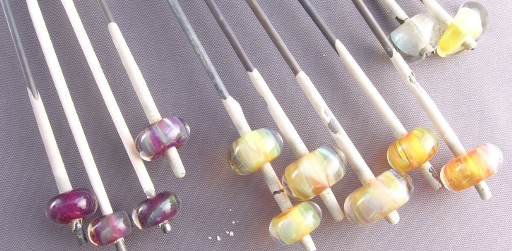- 1st three: carmel luster, cased and partially struck in the flame
- 4th: carmel? luster: full strength tweezer twist, struck in flame
- 5a: dilute warm yellow, plain cased
- 5b: dilute warm yellow, tweezer twist cased, strayed once out of flame
- 6: "sylvus yellow luster?/wave/too hot/strike/(back) cracked-healed-hot
- 7: "sylvus warm yellow core/diluted wave/clear (case)
- 8: "didn't strike?" sylvus warm yellow luster w tweezer twist
- 9: "clear core-sylvus w.y. dilute/t.t./got too hot while striking?
- 10: (burnt mandrel) GA warm yellow, done in class
- 11: (burnt mandrel) "sylvus warm yellow" aka Northstar yellow09?
Kilning: garaged 950 dF, ramped 1150 dF 3hrs, ramped down 1050 ~ 45min?; advanced kiln to ramp-down schedule; shut off at 720dF
I attempted to start the striking process in the flame before putting them in the kiln to continue striking them.
The most interesting thing is that how dilute the warm yellow was had little to do with dark it struck—the darkest bead (on the right) was on the end of a rod with some clear on the tip from the pull. Effectively the bead is a clear core, with a couple of winds of dilute warm yellow and then clear cased—yet it struck the darkest; that is, how dark the beads struck had more to do with how well they were started in the flame.
Other comments: the rods looked very similar, but the unstruck beads (the burnt off mandrels provide good examples:) are somewhat different—the modern GA warm yellow is lighter than the older glass, which my best guess is several year old sample-pack NS 09 yellow.
photos ? file created 23nov08
Unless otherwise noted, text, image and objects depicted therein copyright 1996--present sylvus tarn.
Sylvus Tarn